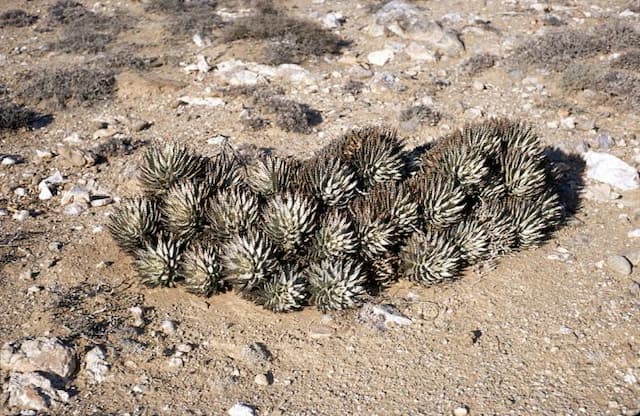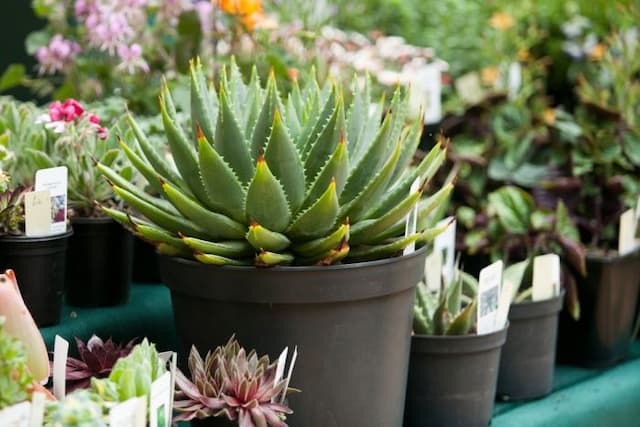Red hot poker Kniphofia 'Toffee Nosed'

ABOUT
The plant commonly known as 'Toffee Nosed' has a distinctive and striking appearance. It is characterized by its bold, poker-like flower spikes that exhibit a gradient of color. The flowers at the top of the spike are a creamy, toffee color, which gives the plant its namesake. As the eye travels down the spike, the blooms transition to a warmer hue, reminiscent of tangerine. These spikes emerge from a robust clump of slender, arching leaves that are a rich green in color, providing a lush backdrop for the dramatic flowering display. The foliage itself can be quite grass-like, creating a tufted mound from which the flower spikes elegantly rise. The overall impression of 'Toffee Nosed' is one of vibrant color and vertical interest, making it a standout in any garden setting where its distinctiveness can be appreciated among other ornamental plants.
About this plant
 Names
NamesFamily
Asphodelaceae.
Synonyms
Red Hot Poker, Torch Lily, Poker Plant.
Common names
Kniphofia 'Toffee Nosed'.
 Toxicity
ToxicityTo humans
The Red Hot Poker is not known to be toxic to humans. However, it is always advisable to avoid ingesting plants that are not specifically intended for consumption as individual reactions can vary.
To pets
Similar to the information for humans, the Red Hot Poker is not commonly listed as a toxic plant for pets. However, ingesting non-food plants can cause gastrointestinal upset in animals, so it is wise to prevent pets from consuming this or any ornamental plant. Symptoms of general plant ingestion could include vomiting or diarrhea.
 Characteristics
CharacteristicsLife cycle
Perennials
Foliage type
Evergreen
Color of leaves
Green
Flower color
Mixed
Height
3-4 feet (0.91-1.22 meters)
Spread
1-2 feet (0.30-0.61 meters)
Plant type
Herb
Hardiness zones
5-9
Native area
Africa
Benefits
 General Benefits
General Benefits- Attractive Flowers - Produces striking bloom spikes with a unique color gradient that can enhance the aesthetics of gardens.
- Pollinator Friendly - Attracts beneficial pollinators like bees, hummingbirds, and butterflies, promoting biodiversity.
- Drought Tolerance - Once established, tolerates periods of drought, making it suitable for xeriscaping and low-water gardens.
- Low Maintenance - Requires minimal care beyond initial planting and occasional watering, making it ideal for busy gardeners.
- Deer Resistance - Typically not preferred by deer, which helps to prevent damage from grazing in areas with deer populations.
- Seasonal Interest - Offers a lengthy blooming period from late spring to summer, providing long-term visual interest.
- Architectural Shape - The upright, sword-like foliage adds structural interest to garden beds and borders.
- Versatility - Can be used in a variety of garden styles, including cottage gardens, coastal gardens, and contemporary landscapes.
- Soil Adaptability - Adapts to a range of soil types, though it prefers well-drained conditions.
- Cold Hardy - Capable of withstanding cooler temperatures to a certain extent, suitable for many temperate climates.
 Medical Properties
Medical PropertiesThis plant is not used for medical purposes.
 Air-purifying Qualities
Air-purifying QualitiesThis plant is not specifically known for air purifying qualities.
 Other Uses
Other Uses- As a source of nectar for beekeeping: Red hot poker plants like Kniphofia 'Toffee Nosed' produce abundant nectar, which can be utilized by beekeepers to help sustain bee populations and produce honey.
- As a natural pest deterrent in vegetable gardens: Some gardeners plant Kniphofia among vegetables to help repel certain pests, as its bright flowers might distract or confuse them.
- In the creation of floral resins and eco-friendly dyes: The vibrant colors of the red hot poker could potentially be used to create natural dyes or resins for crafts and fabrics.
- For educational purposes in botany: Due to its unique characteristics, Kniphofia 'Toffee Nosed' can be used as a study specimen in botany classes to teach about plant adaptations and pollination strategies.
- As a natural compost activator: The foliage and spent flowers of Kniphofia, when added to compost piles, can help speed up the decomposition process due to their nitrogen content.
- For enhancing ponds or water feature designs: The architectural foliage and tall flowers of Kniphofia can be used around ponds and water features to give a vertical accent and exotic look.
- As a seasonal marker in phenological gardens: Red hot poker plants can serve as biological indicators because they bloom at specific times, providing valuable data for phenological studies.
- To create a habitat for beneficial insects: The flowers can attract a variety of beneficial insects, including predatory wasps that help control garden pests.
- In the practice of xeriscaping: Kniphofia 'Toffee Nosed', being drought-tolerant, is ideal for water-wise gardens that require minimal watering and maintenance.
- As inspiration for artists and photographers: The unique shape and coloration of Kniphofia flowers make them striking subjects for artwork and photography, capturing the beauty of the natural world.
Interesting Facts
 Feng Shui
Feng ShuiThe Red Hot Poker is not used in Feng Shui practice.
 Zodiac Sign Compitability
Zodiac Sign CompitabilityThe Red Hot Poker is not used in astrology practice.
 Plant Symbolism
Plant Symbolism- Standout Presence: The Kniphofia, commonly known as the 'Red Hot Poker' due to its striking, torch-like flowers, symbolizes having a standout presence or being the center of attention, often due to one's unique qualities or boldness.
- Fire and Heat: With its vivid fiery colors, the Red Hot Poker represents passion, energy, and warmth, evoking the essence of fire and the heat it brings.
- Attraction and Vibrancy: The plant's bright blooms can symbolize attraction and vibrancy, making it a symbol for drawing in new interests or representing a lively personality.
- Strength and Endurance: As a plant that's tough and drought-resistant, the Red Hot Poker signifies strength, resilience, and the ability to endure challenging conditions.
 Water
WaterRed hot poker plants, including the 'Toffee Nosed' variety, require consistent moisture during their growing season, particularly in the summer, but they do not like to be waterlogged. It's best to water these plants deeply once a week, providing about 1 inch of water which equates to approximately 0.623 gallons per square foot. During hot spells or periods of drought, you may need to water twice a week. Ensure that the soil is well-drained to prevent root rot. Cut back on watering as the plant goes dormant in the fall, and during the winter, only water if the soil is completely dry and there has been no precipitation.
 Light
LightThe Kniphofia 'Toffee Nosed', commonly known as the 'Toffee Nosed' Poker Plant, thrives best in full sun to partial shade. Ideally, the plant should receive at least 6 hours of direct sunlight each day. A position where the morning sun can warm the plant, but where it is protected from the harsher late afternoon sun, is optimal for its growth and flowering.
 Temperature
TemperatureRed hot poker plants like 'Toffee Nosed' prefer moderate to warm conditions and require temperatures between 60°F and 75°F for ideal growth, but they can survive temperatures as low as 14°F and as high as 90°F. They are quite hardy and can withstand a frost, though extended periods of cold below the minimum can damage the plants.
 Pruning
PruningPrune the 'Toffee Nosed' Poker Plant to remove spent flower spikes and tidy up dead foliage. Pruning can be done after flowering, typically in late summer or fall, to encourage more blooms and to maintain the plant’s shape. Additionally, cut back the foliage to the ground in late winter or early spring before new growth begins. Annual pruning is usually sufficient for these plants.
 Cleaning
CleaningAs needed
 Soil
SoilRed Hot Poker (Kniphofia 'Toffee Nosed') thrives in well-draining, fertile soil with a pH between 6.0 and 7.0. A mixture of loam, sand, and compost or well-rotted manure will create an ideal environment for growth. Ensuring good drainage while maintaining some moisture retention is key for robust plants. Amend with organic material annually to keep soil conditions optimal.
 Repotting
RepottingRed Hot Pokers, such as Kniphofia 'Toffee Nosed', do not typically require frequent repotting. These perennials prefer to be left undisturbed and can be repotted every 3-5 years, or when it is evident that the plant has outgrown its current container. Division during repotting can help rejuvenate crowded clumps.
 Humidity & Misting
Humidity & MistingRed Hot Poker (Kniphofia 'Toffee Nosed') is tolerant of a wide range of humidity levels. They do well in the average outdoor humidity and do not require any special humidity adjustments when grown in their preferred conditions. Ensuring proper spacing and air circulation is more critical than adjusting humidity.
 Suitable locations
Suitable locationsIndoor
Place Red Hot Poker in bright light, ensure good airflow.
Outdoor
Plant in sunny spot with good drainage, mulch in winter.
Hardiness zone
6-9 USDA
 Life cycle
Life cycleKniphofia 'Toffee Nosed', commonly known as Red Hot Poker, begins its life cycle when the seed germinates, typically in a moist, well-drained substrate in late winter or early spring. The seedling emerges and establishes a rosette of long, narrow leaves, and as it matures over several months, it develops a strong, fleshy root system. During its growing season, usually in the second year, the plant sends up a tall flowering stalk from the center of the leaf rosette, culminating in a spike of tubular, orange-brown flowers that attract pollinators like bees and hummingbirds. After flowering, which can last for several weeks, the plant sets seed, and the flower stalk eventually withers away. Kniphofia 'Toffee Nosed' is a perennial, so the foliage remains, and the plant can enter a period of dormancy during which it survives on stored energy through winter. The cycle recommences with new growth in the spring, possibly including the division of the plant to give rise to new individuals, enabling the spread and continuation of the species.
 Propogation
PropogationPropogation time
Late spring
The most popular method for propagating the Kniphofia 'Toffee Nosed', commonly known as the Red Hot Poker, is through division. This is ideally done in the spring just before the active growth period begins. To propagate by division, carefully dig up the mature plant ensuring a good amount of the root system is intact. Using a sharp knife or spade, divide the clump into smaller sections, each with a portion of the roots and at least one growth point or fan of leaves. Replant the divisions at the same depth they were growing at originally, spacing them about 18 inches (approximately 45 centimeters) apart to allow enough room for growth. Water the new plants well to help establish them. This method of propagation can quickly produce new Red Hot Poker plants that will grow to resemble the parent plant.









